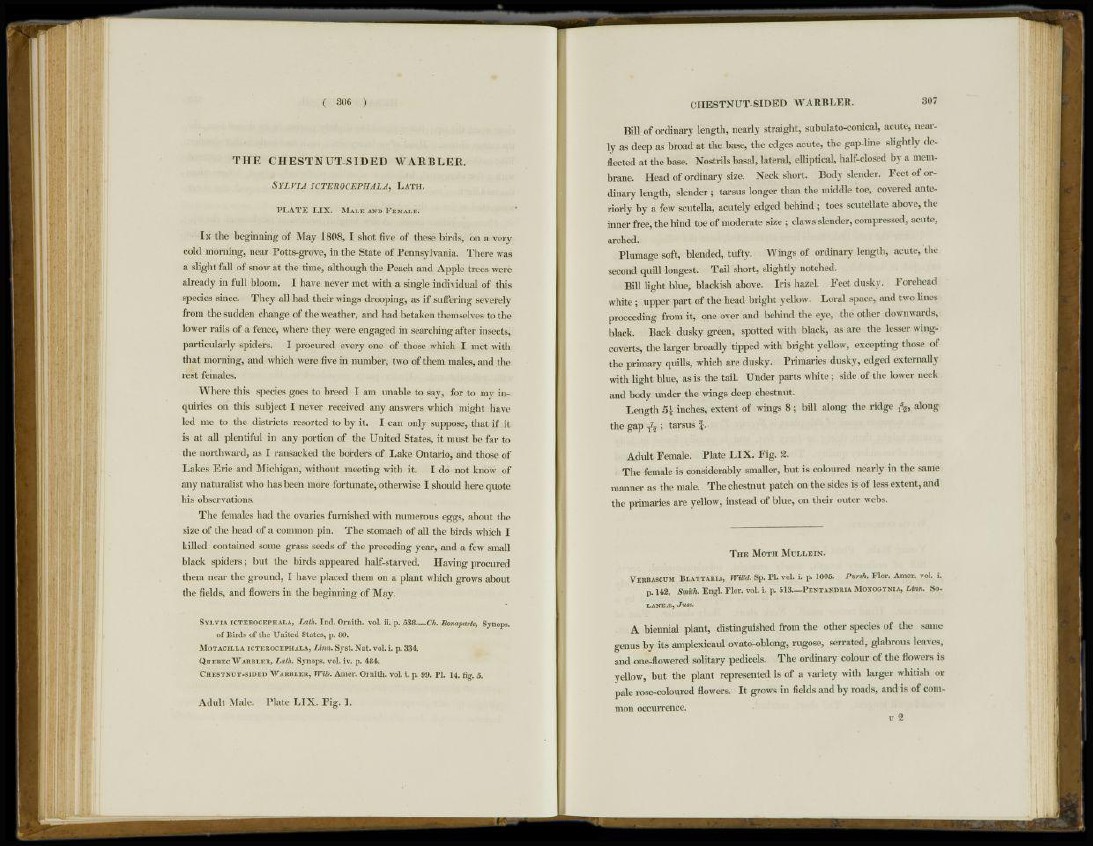
( 306 )
THE CHESTNUT-SIDED WARBLER.
SYLVIA ICTEROCEPHALA, LATH.
PLATE LIX. M A L E A N D F E M A L E .
IN the beginning of May 1808, I shot five of these birds, on a very
cold morning, near Potts-grove, in the State of Pennsylvania. Then' was
a slight fall of snow at the time, although the Peach and Apple trees were
already in full bloom. I have never met with a single individual of this
species since. They all had their wings drooping, as if suffering severely
from the sudden change of the weather, and had betaken themselves to the
lower rails of a fence, where they were engaged in searching after insects,
particularly spiders. I procured every one of those which I met with
that morning, and which were five in number, two of them males, and the
rest females.
Where this species goes to breed I am unable to say, for to my inquiries
on this subject I never received any answers which might have
led me to the districts resorted to by it. I can only suppose, that if it
is at all plentiful in any portion of the United States, it must be far to
the northward, as I ransacked the borders of Lake Ontario, and those of
Lakes Erie and Michigan, without meeting with it. I do not know of
any naturalist who has been more fortunate, otherwise I should here quote
his observations.
The females had the ovaries furnished with numerous eggs, about the
size of the head of a common pin. The stomach of all the birds which I
killed contained some grass seeds of the preceding year, and a few small
black spiders; but the birds appeared half-starved. Having procured
them near the ground, I have placed them on a plant which grows about
the fields, and flowers in the beginning of May.
S Y L V I A I C T E R O C E P H A L A , Lath. Ind. Ornith. vol. ii. p. 538—Ch. Bonaparte, Synops.
of Birds of the United States, p. 80.
M O T A C I L L A I C T E R O C E P H A L A , Linn. Syst. Nat. vol. i. p. 334.
Q U E B E C " W A R B L E R , Lath. Synops. vol. iv. p. 484.
C H E S T N U T - S I D E D W A R B L E R , Wils. Amer. Ornith. vol. i. p. 99. PI. 14. fig. 5.
Adult Male. Plate L I X . Fig. 1.
CHESTNUT-SIDED WARBLER. 307
Bill of ordinary length, nearly straight, subulato-conical, acute, nearly
as deep as broad at the base, the edges acute, the gap-line slightly deflected
at the base. Nostrils basal, lateral, elliptical, half-closed by a membrane.
Head of ordinary size. Neck short. Body slender. Feet of ordinary
length, slender ; tarsus longer than the middle toe, covered anteriorly
by a few scutella, acutely edged behind ; toes scutellate above, the
inner free, the hind toe of moderate size ; claws slender, compressed, acute,
arched.
Plumage soft, blended, tufty. Wings of ordinary length, acute, the
second quill longest. Tail short, slightly notched.
Bill light blue, blackish above. Iris hazel. Feet dusky. Forehead
white ; upper part of the head bright yellow. Loral space, and two lines
proceeding from it, one over and behind the eye, the other downwards,
black. Back dusky green, spotted with black, as are the lesser wingcoverts,
the larger broadly tipped with bright yellow, excepting those of
the primary quills, which are dusky. Primaries dusky, edged externally
with light blue, as is the tail. Under parts white; side of the lower neck
and body under the wings deep chestnut.
Length 5\ inches, extent of wings 8 ; bill along the ridge fa along
the gap -fa ; tarsus J.
Adult Female. Plate LIX. Fig. 2.
The female is considerably smaller, but is coloured nearly in the same
manner as the male. The chestnut patch on the sides is of less extent, and
the primaries are yellow, instead of blue, on their outer webs.
THE MOTH MULLEIN.
V E R B A S C U M B L A T T A R I A , Willd. Sp. PI. vol. i. p. 1005. Pursh. Flor. Amer. vol. i.
p. 142, Smith. Engl. Flor. vol. i. p. 5 1 3 . — P E N T A N D R I A M O N O O Y N I A , Linn. So-
L A X E . I . , JltSS.
A biennial plant, distinguished from the other species of the same
genus by its amplexicaul ovato-oblong, rugose, serrated, glabrous leaves,
and one-flowered solitary pedicels. The ordinary colour of the flowers is
yellow, but the plant represented is of a variety with larger whitish or
pale rose-coloured flowers. It grows in fields and by roads, and is of common
occurrence.
u 2